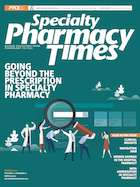Publication
Article
Specialty Pharmacy Times
Going Beyond the Prescription in Specialty Pharmacy
Author(s):
A data-centric approach is vital for patients with complex conditions, particularly in determining what has worked well and anticipating what medical or pharmacy care is required for effective outcomes in the future.
The US health care system consists of thousands of players, each with different functions and objectives. When not fully synchronized, patients often endure a cost-prohibitive, disjointed health care experience. Patients with complex specialty conditions are most commonly affected. Results from an OptumRx assessment revealed specialty patients may take, on average, 13 drugs and see up to 6 independent providers annually.1 That means dozens of consultations, often without critical information shared between physicians and lacking a holistic view of the patient’s health.
Specialty conditions also drive a disproportionate segment of total health care costs. Patients with conditions we define as specialty, such as oncology, multiple sclerosis (MS), and rheumatoid arthritis, account for less than 3% of the member population, yet 40% to 50% of pharmacy spend. Medications that treat specialty conditions cost an average of $75,000 per year, which is up to 50 times more than nonspecialty medications.
To improve quality of care and reduce specialty costs, the health care system would benefit from removing obstacles that reduce the ability to leverage data and analytics to deliver a holistic patient care approach, educate and empower patients and providers with tools and resources, and emphasize individualized, patient-centric treatment plans.
Leveraging Data Analytics
A strong data foundation paired with analytics capabilities can reveal a 360-degree view of the patient. Analyzing medical and pharmacy data side-by-side gives health care professionals greater insight into the specific needs and behaviors of an individual patient. Data can also identify gaps in care to empower physicians or pharmacists to seamlessly address those needs in real time.
A data-centric approach is vital for patients with complex conditions, particularly in determining what has worked well and anticipating what medical or pharmacy care is required for effective outcomes in the future.
Education Through Tools and Resources
An important but often overlooked part of care delivery is patient education. Both clinicians and pharmacists have a unique opportunity to educate patients about complex therapies, ultimately improving patient health and outcomes with better treatment adherence and condition management. One estimate shows that nonoptimized medication therapy generates $528.4 billion annually in drug-related morbidity and mortality costs, which is equivalent to 16% of total US health care expenditures in 2016.2 Research results and pilot programs have confirmed that proper patient education regarding a treatment regimen can significantly lower costs.
New digital solutions are valuable references for patients and physicians alike. Pointing patients in the direction of telemedicine services and digital resources, such as condition-specific live video consultations through BriovaLive and personalized videos through BriovaCommunity, can provide them with valuable touchpoints, particularly for patients who are feeling overwhelmed with a new diagnosis.
Prescribing physicians can use tools such as OptumRx’s PreCheck MyScript to identify alternative, equally effective treatments at a lower cost. To date, 1 of 5 transactions with a recommended alter- native resulted in the provider choosing an alternative drug, delivering significant cost savings for patients and payers. PreCheck MyScript also gives physicians visibility into a patient’s drug coverage and whether a medication requires a prior authorization. More than 30% of PreCheck MyScript prior authorizations were initiated electronically or avoided altogether as a result of access to real-time patient-specific benefit information. This improves patient adherence by increasing the likelihood a patient will get the proper medication in time and without avoidable hurdles.
Taking an Individualized Patient Approach
Since specialty cases should be managed on an individualized basis, health care professionals working with specialty patients must be multidisciplinary, with oversight of both medical and pharmacy, to manage the patient’s total health.
Approaching clinical management using a therapy solutions model puts the patient at the center and creates a unique, end-to-end, disease-specific clinical method to patient care. For example, with no cure available, patients with hemophilia must undergo challenging and ongoing expensive treatments. Deploying a dedicated team of hemophilia experts who serve each member and caregiver individually with education and synchronized care increases patient adherence and satisfaction with their care experience.
These integrated teams—comprising hemophilia expert pharmacists, patient care coordinators, patient care advocates, and nurses—have insight into a patient’s prescriptions and medical history so they can provide comprehensive support. We recently launched a similar program to support patients with MS, another complex chronic disease often accompanied by comorbidities.
Another example of a patient-centric approach is managing patients who take cancer medications that may cause severe adverse effects. Through our split fill program, half of a regular prescription amount is provided to patients. Care providers check in with them early and often to manage potential clinical adverse effects. In addition, clinicians conduct regular drug utilization reviews and then notify the patient, caregiver, or provider of any recommended changes in dosage or medication.
These programs increase adherence, identify potentially harmful drug interactions, and cut down on waste, which saves significant amounts of money. Early results from these programs have shown 96% of enrolled patients are more likely to tolerate therapy. For the 4% of patients who are unable to tolerate their medications, we help them through the discontinuation, which can result in pharmacy savings of $2500 per discontinued patient per year.
Patients Remain at the Center
Optum advocates smart, safe use of health data to improve patient care, reduce costs, and advance development of a more responsive patient-centered health system. Collectively, we must not lose sight of the fact that the patient needs to be at the center of everything we do. With the health care landscape constantly transforming, the roles and functions of individual players may vary but our objective stays the same. Health care organizations share a great opportunity to improve the quality of outcomes and lower specialty costs by educating patients, empowering physicians, leveraging data and analytics, and ultimately personalizing our approach to patient care.







